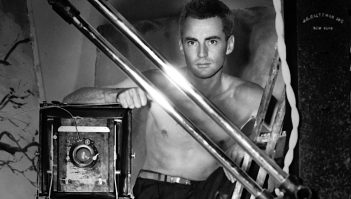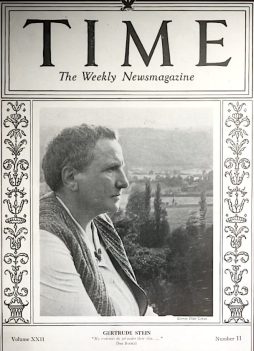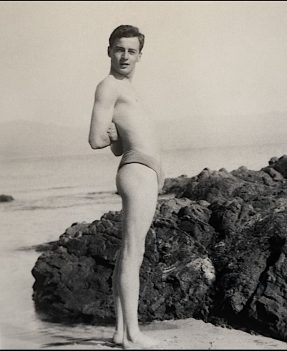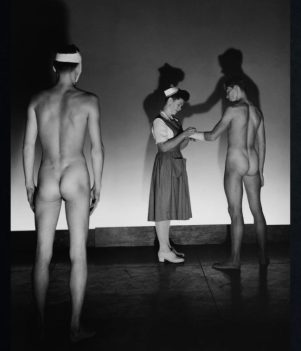By Robert St. Martin

Los Angeles, CA (The Hollywood Times) 7/14/23 – One of the best documentaries at Outfest Los Angeles this year is Sam Shahid’s Hidden Master: The Legacy of George Platt Lynes. George Platt Lynes (1907–1955) began his career photographing celebrities and to the general public, he is mostly known for his portraits along with his extravagant fashion work. However. George’s heart, his passion, and his greatest talent lay elsewhere, in his work with the male nude. This work, sensuous and radically explicit for its time, has only recently begun being fully discovered and appreciated for the revolution that it represents in the history of 20th American photography. From his first contact with expatriate writer Gertrude Stein to his late friendship with Dr. Alfred Kinsey of the Kinsey Institute for Sex Research at the University of Indiana at Bloomington, Lynes led a charmed life as a beautiful boy among beautiful men. Director Sam Shahid has delved into the relatively unknown master photographer George Platt Lynes and drawn on art experts and those surviving artists who were once part of Lynes’ charmed circle.

The film relies heavily on the artistic legacy of renowned, American photographer George Platt Lynes through this exhibition of photographs from the collection of the Kinsey Institute at Indiana University, to whom Lynes gave about 1,000 photographs. Lynes’ visionary work catapulted him to notoriety as a photographer for New York-based commercial fashion and for the New City Ballet. But he drifted from the spotlight as the commercial style of fashion photography changed in the mid-1940s. It seems that his homosexual interests and focus on photographing male nudes began to dominate his time. From the beginning of his work with the camera, Lynes also turned his lens on his social circle – the artistic and literary minds of the mid-20th century – who accepted him as a gay man during a period of harsh anti-LGBT laws in America.

He was sent to Paris at age 18 in 1925 by his father, who was an Episcopalian clergyman; his mother was a high-society socialite. Once in Paris, George met Gertrude Stein and her large circle of friends who were part of the modernist cultural scene. She considered George to be a cute “little boy” but he soon became romantically involved with the expatriate novelist Glenway Westcott and the publisher and art critic, who were inseparable. The peripatetic threesome maintained a polyamorous connection that lasted some 15 years. Their New York apartment became a mecca for elegant cocktail and name-dropping dinner parties. Their ménage-à-trois complicates our understanding of the pre-Stonewall gay “closet.”

From age 18, Lynes entered the cosmopolitan world of the American expatriate community in Paris when he became acquainted with the salon of Gertrude Stein and Alice B. Toklas. Gertrude Stein liked his photography, and it was Lynes who took the photograph of Gertrude Stein at the time of publication of her Four Saints in Three Acts that ended up on the cover of Time Magazine. Intending to pursue a literary and small press publishing career, Lynes also began photographing authors like Stein, Jean Cocteau, André Gide, and Colette. He returned to the United States to attend Yale University but dropped out within a year. Then he went back to France to be with Westcott and Wheeler near Nice. The three lived together above a bar frequented by sailors. Lynes was in love with Monroe Wheeler and Glenway was just part of arrangement.

Returning once again to the United States, he hoped to have a literary career and he even opened a bookstore in Englewood, New Jersey in 1927. He first became interested in photography not with the idea of a career, but to take photographs of his friends and display them in his bookstore. Returning to Paris the next year in the company of Wescott and Wheeler, he traveled around Europe for the next several years, always with his camera at hand. He developed close friendships within a larger circle of artists including Jean Cocteau and Julien Levy, the art dealer and critic. His friends suggested the Lynes make a living out of photography and that is what he did taking photos of Paris celebrities including Colette, Diane Vreeland, Katharine Hepburn, Noguchi, Orson Welles, Joan Miro, Andre Gide, and other writers. Levy would exhibit his photographs in his gallery in New York City in 1932 and Lynes would open his studio at 44 East 50th Street there that same year. Lynes’ fashion photocopy incorporated aspects of mythology, surrealism, and theater.

Wescott and Wheeler eventually returned to the United States in 1934 and maintained an apartment in Manhattan with photographer George Platt Lynes. There were two bedrooms and George slept in the same bed with Monroe Wheeler. When his brother Lloyd moved to a dairy farm in Union Township, near Clinton, New Jersey, in 1936, Wescott along with Wheeler and Lynes took over one of the farmhand houses and named it Stone-Blossom. The relationship of the three men was well-understood by their circle of friends, including Paul Cadmus, whose painting “Stoneblossoms” depicts the three men at the farmhouse. Paul Cadmus was married but had a bisexual boyfriend Jared French, and that trio lived together.
George took photos of all his circle of friends – including Cecil Beacon and Jean Cocteau, as well as Christopher Isherwood, Marsden Hartley, George Tooker, Pavel Tchelitchew, and Bernard Perlin – all of whom were gay or bisexual. As Bernard Perlin explained it, “They were addressing each other in their painting and photography.” They were the first gay artists – not everyone was in the closet. The closet was enormous. The gay cocktail parties were the way you met gay people in New York.

Some of the surviving artists and writers who once knew Lynes comment on him in the course of the documentary. He was part of a privileged and mostly affluent group of gay men who had time and resources to “play.” He is described as being “the personification of a grand queen – always the center of attention.” He was “very self-centered and egotistical, but very loving at the same time.” He loved to sunbathe, and always had a suntan, and he smoked incessantly. “He was obsessed with beautiful people because he was one of them.” Lynes never had to “come out” of the closet because he was never “in” it.

He actually attended the same preparatory school with Lincoln Kirstein, who founded the New York City Ballet and brought Balachine to the United States; later Kirstein made Lynes the official photographer of the ballet company – a position he held for 30 years. During this time, Lynes continued to shoot male nudes in the same studio that he used for high-end fashion photography. Often, he used male dancers from the ballet as nude models. These nude male photographs are genuinely erotic but sophisticated. They were never written about, never published, never shown in museums or galleries. He was friends with Christopher Isherwood, whose partner Donald Bachardy posed for Lynes in his photo studio.

In 1942, George had fallen in love with his studio assistant George Tichenor, who was unfortunately killed in combat in the war. Then he pursued Tichenor’s younger brother Jonathan. In 1945, he finally decided to leave his domestic arrangement with Wheeler and Westcott. Believing that he was madly in love in move in with Jonathan Tichenor, he got an apartment of his own with Jonathan. But that relationship did not last. Nevertheless, the romantic attachment of Wescott and Lynes remained strong throughout their lives. Wescott was at Lynes’ bedside when he died of lung cancer in December 1955 at age 47.

Much of the story of the life of George Platt Lynes is recounted in the recent book by Allen Ellenzweig, in his George Platt Lynes: The Daring Eye (Oxford UP, 2020). Ellenzweig provides some key commentary in the film. Also important are the words of the painter Bernard Perlin, to whom Lynes were strangely connected as “two homosexual men who love each other without going to bed together.” In 1953, Lynes convinced Perlin to come back to New York City from Rome to live with him. As Perlin explains: “George got around. He was a hungry soul. He was in love with a lot of people.”
 But Perlin, who eventually became the artistic executor of Lynes’ estate and work, says of Lynes: “All of his sex life was based not most, but all, on beautiful boys . . . and one woman.” Apparently, while sharing an apartment with Perlin, Lynes He had an off-and-on relationship with Dougie (Maurice Douglas), a fashion model in 1940s. Some of Lynes’ last photograph seems to have moved into topics other than the Adonis-like poses of his male nudes.
But Perlin, who eventually became the artistic executor of Lynes’ estate and work, says of Lynes: “All of his sex life was based not most, but all, on beautiful boys . . . and one woman.” Apparently, while sharing an apartment with Perlin, Lynes He had an off-and-on relationship with Dougie (Maurice Douglas), a fashion model in 1940s. Some of Lynes’ last photograph seems to have moved into topics other than the Adonis-like poses of his male nudes.
The most significant friendship that Lynes developed in his last years was with Dr. Alfred Kinsey of the Kinsey Institute for Sex Research at the University of Indiana, Bloomington. We learn in the course of the film why Lynes gave Kinsey about 1,000 of his photographs – many of which were male nudes. These have been preserved in the library there and serve as many of the images we see in the documentary. There is also a strange, uncanny tale about how a billionaire philanthropist and collector Fred Koch (of the same Koch family that supported Trump in his first election) purchased the estate of Lynes from Bernard Perlin in 1985 and those meticulously organized items were unknown until the death of Koch in 2020.
The legacy is of the life work of George Platt Lynes stayed in the closet – or rather the archives of philanthropist and collector Fred Koch. Male nudes have never been acceptable at the museum level. There is a double standard which was not openly questioned until Robert Mapplethorpe began to show his work at art galleries in the 1980s. As the curator of the first exhibit of the photographical career of Lynes in Indianapolis points out: “In every art museum there are nude women, but if there is one penis in a museum, everyone is freaking out. The male body is much more threatening.” Charles Leslie, of the Leslie-Lohman Museum of Lesbian and Gay Art, says it as it is: “It has to do with American Puritanism.”
Hidden Master: The Legacy of George Platt Lynes screens at Outfest on Sunday, July 16, at 1:45 PM at the Directors Guild of America, Theatre 1. Expected to attend: Sam Shahid (Director, Writer, Producer), Matthew Kraus (Writer, Producer), John MacConnell (Producer), Conor McBride (Editor), Nando de Carvalho (Producer). The film will also be available for viewing online from July 17 through July 23 via Outfest Screaming. For tickets, go to: www.outfest.org.




